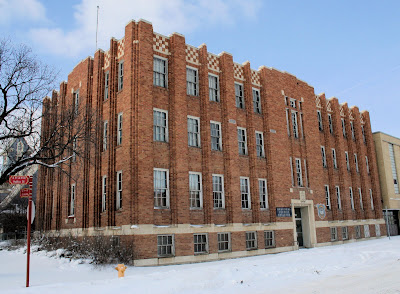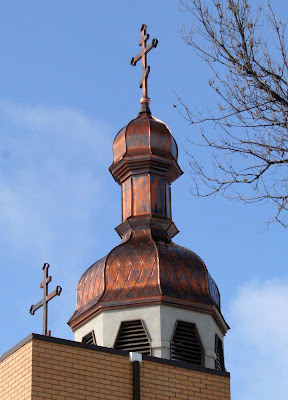The second tour I photographed Friday for my Historic Walks of Regina and Moose Jaw book was Germantown.
You may be wondering about the name. From the introduction to this section in the book:
Germantown…emerged as a distinct residential and commercial neighbourhood in the early 1900s. Regina Market Square, established in 1892, was a public marketplace that became an important commercial district in the city’s early years, particularly for the grocery and produce trade, although its businesses also provided agricultural and building supplies, clothing, housewares, furniture and a variety of services. Delivery stables and blacksmith shops abounded in the area, and at one time three hotels bordered the square.
The district took its name from the large number of European immigrants (primarily German) who first took up residence here. The German community soon set up its own religious and educational institutions and services. As its members found employment, they began to build their own homes.
Here’s the signature building, Number One Fire Hall, in both wide-angle and artistic flag-flying views:


Architects Clemesha and Portnall designed this 1921 building, whose exterior design and decoration are unique in Western Canada. (Portnall spent some time in Belgium after the First World War, and apparently drew some inspiration from there; the fire hall is reminiscent of the town halls of northern Europe.) At the time of its construction the fire hall was on the southern periphery of Regina Market Square, and it incorporates the foundations, basement and segments of the first-storey wall of the Regina Market Building, built in 1908.
This was the third fire hall built in Regina, and it was immediately criticized by Fire Chief William White for being less spacious than the previous one, and (ironically) inadequately fireproofed
Nevertheless, this remained Fire Hall No. 1 until 1984, when two new stations were built.
Basically next door to Fire Hall No. 1 is an Art Deco-style building I had never seen (or at least noticed) until now: the Municipal Justice Building, built as the new headquarters for the city police department in 1930 (before that the police operated out of the basement of Alexandra School) at a cost of $113,000.

There were, in fact, several buildings in this area I’d never seen before, including the Ukrainian Orthodox Cathedral of the Descent of the Holy Ghost, built in 1960. Its copper-sheathed onion domes are particularly impressive:

Finally, I’d never seen these impressive Corinthian columns, in front of the modern (1988) St. Basil Manor Apartments, built on the initiative of the local Ukrainian-Greek Catholic community. These came from the former Royal Bank of Canada building downtown, built in 1917, closed in 1985, then demolished to make way for what is now FCC Tower/Agriculture Place, headquarters of the Farm Credit Corporation.

Lots of other interesting buildings in the area–guess you’ll have to buy the book!
Tomorrow, weather permitting, I’ll be in Moose Jaw, then Wednesday I’ll be shooting the Warehouse District.








2 comments
Mac,
The book is due out sometime this year…I keep expecting to get the page proofs, but haven’t seen them yet.
I think the actual introduction to Germantown in the book makes some of the same points you do about the mixture of nationalities represented in the area.
Glad you enjoyed the photos!
I just stumbled across your blog: terrific photos; I look forward to the book. Any idea when it might be published? One minor point regarding the excerpt from the introduction, concerning “Germantown.” Actually, if one had grandparents who lived in Regina at the turn of the 20th century, one would have heard the word “German” used in a rather broader sense than your text contemplates. Germantown wasn’t in particular settled by literal Germans, though there were of course plenty of those. The WASP mainstream referred to any continental Europeans — Germans, Romanians, Hungarians, Serbs, Ukrainians, Poles, essentially anyone neither British Isles, French nor aboriginal in ancestry — as either “Germans” or “Galicians” (Galicia actually then being Austrian Poland): the terms overlapped. A quick review of the churches in the neighbourhood gives one the idea: Trinity Lutheran (old building); the Ukrainian Orthodox Church of the Descent of the Holy Ghost; Holy Trinity Serbian Orthodox Church; St George’s Romanian Orthodox Cathedral; St Nicholas’s Romanian Orthodox Church; St Mary’s Roman Catholic Church. (Only Trinity Lutheran and St Mary’s Roman Catholic Churches would especially have catered to literal Germans.) I’ve been writing this up for the Wikipedia article on Germantown (http://en.wikipedia.org/wiki/Regina_neighbourhoods#Germantown); there are a few historic photos. It would be wonderful to have some current non-copyright ones but such is life.
Incidentally, a minor correction: the Ukrainian Orthodox Church of the Descent of the Holy Ghost is a parish church, not a cathedral.
Best wishes
Mac Robb
Brisbane, Australia